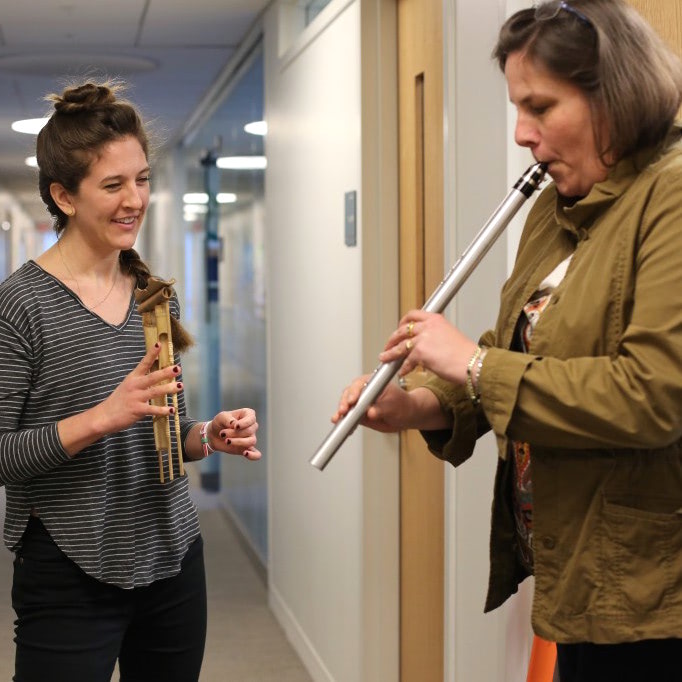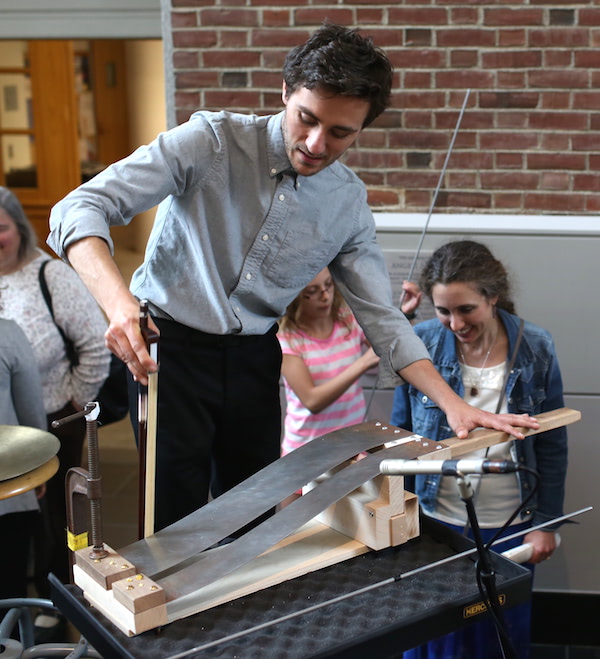- Undergraduate
Bachelor's Degrees
Bachelor of ArtsBachelor of EngineeringPartner School Dual-DegreeUndergraduate AdmissionsUndergraduate Experience
- Graduate
Doctoral Degrees
Doctor of PhilosophyPhD Innovation ProgramDoctor of Medicine-PhDGraduate AdmissionsGraduate Experience
- Research
- Entrepreneurship
- Community
- About
-
All Thayer News

Molly Herron listens as Professor Ulrike Wegst demonstrates an aluminum clarinet made by students. (Photo by Rob Strong.)

Demonstrating a student-made instrument at the concert. (Photo by Rob Strong.)
Composer Molly Herron Inspired by Materials Science and Engineering Research
May 16, 2017

Molly Herron listens as Professor Ulrike Wegst demonstrates an aluminum clarinet made by students. (Photo by Rob Strong.)
Earlier this month, Brooklyn-based composer Molly Herron — the third composer commissioned by the Hopkins Center’s STEM (science, technology, engineering and math) Arts program — premiered "Assembly," a work composed in collaboration with Thayer School of Engineering and performed on instruments made by students.
Herron taught a four-day intensive course offered by Thayer in partnership with the Hopkins Center in which eight students designed and built an array of musical instruments, experimenting with materials, sounds, and structures not found in a typical orchestra. Co-teachers were engineering professors Vicki May and Ulrike Wegst.
In the concert program notes, Herron writes:
"Assembly" was inspired by the people and programs at Thayer School of Engineering, where I spent time during 2016 and 2017 becoming acquainted with the community and their work.
During my time at Thayer, it struck me that engineering is a deeply inclusive field that brings together people from all backgrounds. I met mathematicians, physicists, and inventors; people working in medicine, and with robotics. I was so impressed by the creativity and diversity of the work getting done under the Thayer umbrella. When I asked, "Why are you here in the engineering department and not in the math/ physics/medical/etc. department," the answer was inevitably, "Because I like to make things." Much of my understanding of what makes engineering (and Thayer in particular) unique came to be about this idea of application: making things that step out into the world and affect peoples' lives. This is reflective of music. Musicians often go off into a room to think and theorize by ourselves, but at the end of the day, we build something and share it with people.
The title, "Assembly," refers not only to engineers (and composers) creating materials and building, but also the way projects bring people together. …
… For the creation of this piece I am deeply indebted to Professors Ulrike Wegst and Vicki May. They have been supportive and enthusiastic in myriad ways throughout my time at Thayer, chiefly through co-teaching the instrument building workshop with me and handling all of the logistics to make it happen.
To Professor Wegst I am additionally indebted for her research* on the materials used in musical instruments. I continuously referenced her articles during the writing of this piece; the text, while it can’t exactly be attributed to her, is drawn from her research.
(See the full text of her program notes.)

Demonstrating a student-made instrument at the concert. (Photo by Rob Strong.)
The concert, held in Thayer's MacLean Engineering Sciences Center, featured the student-made instruments played by Tigue, a percussion ensemble with ties to Dartmouth. Herron’s work was commissioned by the Hopkins Center as part of a multiyear project blending science with art, funded by the Andrew W. Mellon Foundation.
*Materials for Musical Instruments:
- Wegst, U.G.K. (2006) Wood for sound, American Journal of Botany, 93 (10), 1439–1448.
- Wegst, U.G.K., (2008) Bamboo and Wood in Musical Instruments, Annual Review in Materials Research, 38, (doi:10.1146/annurev.matsci.38.060407.132459).
- Wegst, U.G.K., Oberhoff, S., Weller, M. and M.F. Ashby (2007) Materials selection criteria for violin bows, International Journal of Materials Research, 12, 1230–1237.
For contacts and other media information visit our Media Resources page.
